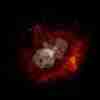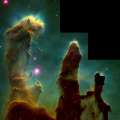Images - 2
Mayall's Object
Mayall's Object (Arp 148) is almost certainly the result of a collision between two galaxies; perhaps a small galaxy passing through a larger galaxy. The collision produced a shockwave that first drew matter into the center and then caused it to propagate outwards in a ring. The elongated companion perpendicular to the ring suggests that Arp 148 is an ongoing collision. It is in the constellation of Ursa Major, the Great Bear, and is more than 150 Mpc (about half a billion light-years) away.
Eta Carinae & the Homunculus Nebula
Hubble image showing the supermassive star Eta Carinae and the bipolar Homunculus Nebula which surrounds it. The Homunculus was partly created in a "supernova imposter" event of Eta Carinae, the light from which reached Earth in 1843, when it became one of the brightest stars in the southern sky. Eta Carinae itself appears as the white patch near the center of the image, where the 2 lobes of the Homunculus touch. Although the star released as much visible light as a supernova explosion, it survived, producing two lobes and a large, thin equatorial disk, all moving outward at more than half a million miles per hour. It is about 7,500 to 8,000 light-years away, and the main star is between 85 and 195 times the radius of the Sun, and 100 to 150 times as massive. It is a Wolf-Rayett type of star, less than 3 million years old, and will not survive much longer. There is also a stunning NASA/ESA picture of the Eta Carinae Nebula, with the star's position marked by the blue arrow.
Eagle Nebula
Two beautiful images from the Hubble of some of the huge pillars within the Eagle Nebula (M16). These are regions where stars are forming in huge numbers, many much larger than the Sun. On the right is the famous picture of the "pillars of Creation", which are several light-years tall. On the left is the column called "the Spire". It is about ten light-years tall. The nebula is about 7,000 light-years away, so we are seeing it as it was 7,000 years ago. It is about 70 by 55 light-years in size, and it is about 5.5 million years old. Sadly, the Pillars were probably destroyed by a nearby supernova explosion some 6,000 years ago, so we will only be able to enjoy them for about another thousand years as it will take the light from the modified nebula that much longer to reach us!
Nebula NGC 604 in M33 (Triangulum)
NGC 604 is a huge nebula located in one of the spiral arms of our neighboring galaxy M33, Triangulum, which is about 2.7 to 3 million light-years away. The nebula is nearly 1,500 light-years across, making it many times larger than even the entire Orion Molecular Cloud Complex. Placed at the same distance as the Orion Nebula, which is visible to the naked eye, NGC 604 would be brighter than Venus. A spectacular object, it contains more than 200 large (from 15 to 60 solar masses) hot stars, that heat gas around the nebula making it fluoresce.
Astronomy & Cosmology






